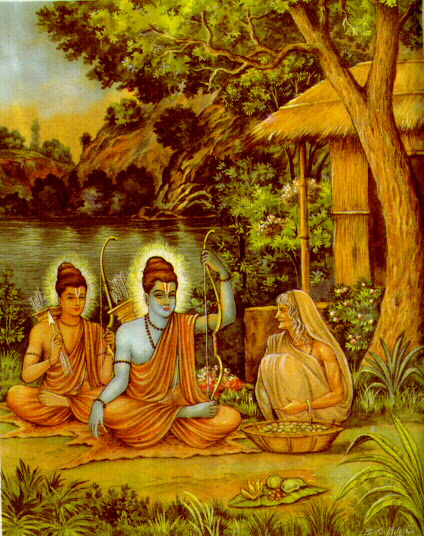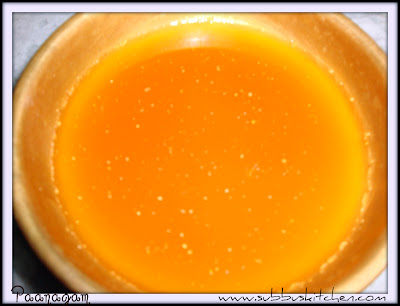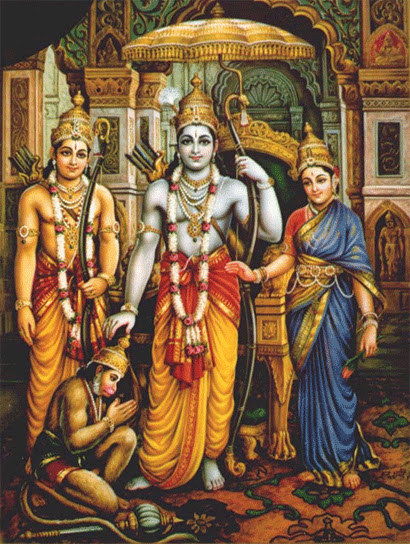| Best wishes for SriRAM Navami
SriRama, Sita, Hanuman
Neelambhuj shyamalkomlang Sita Samaropitvambhagam Pano Mahasaikacharoochapam Namame Ramam Raghuvanshnatham Rama Gayatri Mantra Om Daserathaya Vidhmahe Sita Vallabhaya Dheemahe Thanno Rama Prachodayath.  Ram Navami celebrated in order to commemorate the birth of Lord Rama. As Rama was considered the seventh incarnation of Lord Maha Vishnu, the festival is held in high regard by Hindus all over the world. On this day, he devotees of Ram all over the world
observe fast and engage
in the worship of Ram. It is said that Ram Navamiis the oldest festival in the Earth from time immemorial, Ram Navami is the festival of masses. Apart from God or avtar (incarnation) of God, Lord Ram is regarded as an ideal king, ideal son, ideal husband and an ideal brother. It is said that Ram naam (the name of Lord Rama)in itself is a divine mantra and simply chanting this Ram (Ra ma) helps one to attain salvation. The Mantra ‘Ra ma’ is called the Thaaraka mantra. It is a combination of 'Namasivaya mantra' and the'Om Namo Narayanaya maha mantra' thereby representing the union of Shiva and Narayana. Another popular mantra of Rama is _,_.__  
Sabari,
 
Sugreeva,& Bali

Ram Navami is a Hindu festival, celebrating the birth of Lord Rama, son of King Dasharatha of Ayodhya, and 7th avtar of Lord Vishnu. The day is called Rama Navami as it falls on Navami. The birth of Rama on earth is to vanquish the roots of Adharma. Lord rama was born on earth to destroy the demon Ravana.

Story behind: Generally hindus will consider Ashtami and Navami day of each month as unaspicious and will not perform any good events on those days. So Ashtami and Navami went to Lord Vishnu and expressed their unhappiness. To make them happy and to make Dharma rule over Adharma Lord Vishu born as Rama on a Navami Day. The same way Lord vishnu born as Krishna on an Ashtami day which is what we celebrate as Krishashtami(Krishna Jayanthi).
Ram Navami in 2014 is on 8th April 2014 Tuesday. It is considered auspicious to perform elaborate pujas and chant the name of Rama. It is good for the devotees if they hear Ramayana story on that day and also if they chant Ramar Patabishegam episode of Ramayana on that day. Also devotees should prepare the following recipes as neivedhyam and get the blessings of Lord Rama.
Recipes:
 Panagam Panagam
Ingredients:
Method:
Neer Moor
Ingredients:
Method:

Greetings to all
OM SAIRAM
VISIT BLOG &FWD TO YOUR FRIENDS
SMILE WITH
RAMNATH&FLY |
OM SAIRAM Always be happy always wear a smile..not because life is full of reasons to smile but ur smile itself is the reason for many others to smile YOU MAY VISIT&FWD TO YOUR FRIENDS &GIVE ME FEED BACK, ramajayamgomati.blogspot.com Please do visit my blog and see what I have posted. Comments are requested THANKS REGARDS OM-SAIRAM
Pages
Popular Posts
-
Pongal Puja – How to do Thai Pongal Pooja? Talk about Pongal festival and the first thing that comes to mind is the boiling over of...
-
HAPPY NEW YEAR "Cheti Chand jyon Lakh Lakh Wadayun Athav" J A I J H U L E LA L May Peace Hope ...
-
Michhami Dukkadam! On this auspicious occasion of Paryushan we wish you all Michhami Dukkadam! We beg your forgiveness from in...
-
Today is Ashadi Ekadasi or Shyani Ekadashi. Shirdi Majhe Pandarpura Sai Baba Ramavara. (Shirdi is my Pan...
-
Dear parivar members / friends / well-wishers, Greetings & Namaskar. तुम्हा सर्वाना शुभ मकर संक्रांति Til gud ghya, god god...
-
Paryushan Parva is the king of all festivals and hence is known as Parvadhiraj. Parvadhiraj Paryushana, this festival has the...
-
!Good Morning ~Have A Nice Day ! ONE . N ever Loose ur Confidance , Work Hard to Achieve ur Goal, Learn from Failure Then u can ge...
-
Nine Colours of Navratras&Wish you allSHUBHA NAVRATRI W hats navratra? N- nav chetna A- akhand jyoti V- vighn nas...
-
HEARTY TAMIL NEW YEAR GREETINGS் ( இனிய தமிழ் புத்தாண்டு நல்வாழ்த்துக்கள் ) ...
Monday, April 7, 2014
Best wishes for SriRAM Navami
Subscribe to:
Comments (Atom)




